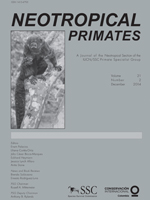Rivers are considered to influence the current patterns of ecological and genetic variation of Amazonian species and communities (Gascon et al., 2000). Rivers are impenetrable barriers to the dispersal of several vertebrate species, and, in some cases, they interrupt the expansion of species from their origin centers and gene flow between populations of sister species from opposite margins (Sick, 1967; Hershkovitz, 1977; Ayres and Glutton-Brock, 1992; Gascon et al., 2000). Hence, rivers drive, inter and intraspecific differentiation patterns in the distribution of Amazonian primates (Ayres and Glutton-Brock, 1992).
There are few records of New World primate species swimming (Parnell and Buchanan-Smith, 2001). Some platyrrhines, such as Cebus, Cacajao, Aotus, and Saimiri, can inhabit or use swamps and seasonally flooded areas, but they do not swim between habitat patches (Socoloske and Kymberley, 2010; Bezerra et al., 2010). The only reports of swimming refer to large primates, such as Alouatta palliata, Cacajao melanocephulus, as well as large species of Old World cercopithecoids: Macaca radiata (bonnet macaque), Nasalis larvatus (proboscis monkeys), Papio anubis (olive baboon), Macaca fuscata (Japanese macaques), Pan troglodytes (chimpazee), and Pongo pygmaeus (bornean orangutan) (Wata, 1981; Yeager, 1991; Forthman, 2000; Agormoorthy et al., 2000; Gonzalez-Socoloske and Snarr, 2010; Bezerra et al., 2010; Bender and Bender, 2013). Among the largest platyrrhines are the atelids, such as the black spider monkey (Ateles chamek), which may weight up to 10 kg and has two common characteristics of the subfamily Atelinae: immigration and movement through semibrachiation (Chapman and Chapman, 1989; Chapman and Chapman, 1990; Campbell et al. 2005). Ateles chamek occurs in lowlands from northeastern Peru, northern and central Bolivia in the Noel Kempf Mercado National Park, and western Brazil in the state of Mato Grosso on the left margins of the rivers Teles Pires and Tapajós (Wallace et al., 1996; Iwanaga and Ferrari, 2002). There are reports of black spider monkeys using the ground to socialize, collect food, and cross open areas (Di Fiore, 2002; Campbell et al., 2005). However, there is no information on swimming. Therefore, we report a rare case of swimming by a female A. chamek in an Amazonian River.
On November 28th, 2012, in the municipality of Comodoro (13°47′54″S, 60°27′53″W), in the Amazon of Mato Grosso, we observed a female A. chamek crossing the Guaporé River by swimming. Approximately at 16:30 h, the female began moving on the ground of the river’s beach, which is located within the Noel Kempff Mercado National Park in the municipality of Santa Cruz, Bolivia (Fig. 1). Next, the specimen began to swim towards the opposite margin, located in the state of Mato Grosso, Brazil. The swimming activity lasted ca. 15 min, and the specimen crossed 38 meters from one margin to the other. The specimen had the body completely submerged, leaving only the head out of the water (Fig. 2), and moved its arms and legs. It was panting and was not scared by our boat; on the contrary, it even climbed onto the boat and walked around the boat's edge before immersing back into the water. Then, the specimen managed to climb onto a submerged branch and began a fast movement between tree crowns in the riparian forest of the Guaporé River, on the Brazilian side (Fig. 3).
Figure 1.
Location of the swimming of black spider monkey (Ateles chamek) in Guaporé River, border between Bolivia and Brazil in South America. Tropical and subtropical moist forests; Tropical and subtropical savannas; Floodplains; Tropical and subtropical dry forests; Moutain grasslands. Habitat types follow Olson et al. (2001).

Figure 2.
Photography of the adult female black spider monkey (Ateles chamek) swimming towards the shore of the state of Mato Grosso, Brazil. Photo Credit: Antonio Linares

Figure 3.
Locomotion of the adult female black spider monkey (Ateles chamek) on a submerged branch prior to climbing to tree crowns in the riparian forest of the Guaporé River in the state of Mato Groso, Brazil.

The present report is consistent with the meta-analysis by Ayres and Clutton-Brock (1992), which assessed the relationship between the width of Amazonian rivers and the body weight of primates. This meta-analysis assumes that larger species are less affected by ecological barriers, which means that speciation and interspecific differences between primate communities in the Amazon may be correlated with the ability of the species to cross ecological barriers. Another factor that could have favored swimming by the female A. chamek is the morphodynamics of the Guaporé River. According to Souza-Filho et al. (1999) the Guaporé River has a fluvial meandering channel with the formation of beaches in the dry season. Rivers with sinuous conformation and sand banks on their margins allow animals to cross them, which lead to possibility of crossing of terrestrial vertebrates between opposite margins (Ayres and Clutton-Brock, 1992). In this scenario, the breaking of a physical barrier may favor gene flow between sister species of primates that evolved in opposite margins of Amazonian rivers and help us understand species distributions.
Acknowledgements
The present study received logistic support from Biocev and Environmental Consulting Services. We thank Leandro S. Moreira and Leandro Scoss for comments on the manuscript, and Antonio Meira Linares for providing us with the photos of Ateles chamek.





